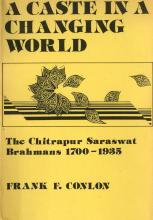In this narrative history of a single caste of western India from the eighteenth to the twentieth century Mr. Conlon examines the background of the caste's separate identity and the evolution of social and economic patterns and institutions which contributed to its maintenance.
While tracing the growth of the Saraswat Brahmans from a small, relatively insignificant group to a thriving community of 15,000 persons in the 1930s, Mr. Conlon explores how modernization influenced the Saraswats and how caste membership conditioned their responses to forces of change. In doing so, he draws on government documents, temple and monastery records, newspapers, family histories, caste publications and personal interviews.
He begins with a discussion of the Gaud Saraswat Brahman caste cluster of Goa from which the Saraswats emerged, and then describes their creation of a separate caste possessing a distinctive religious affiliation with a new spiritual lineage of swamis (preceptors). There follows an analysis of the significance of British rule for the Saraswats in terms of access to government jobs, education, assimilation of new values, and expansion of "traditional" religious activity. Migration to cities, particularly Bombay and Madras, created formidable problems of urbanization involving strains in the religious and social life of the caste, which were intensified because of conflicting innovations by orthodox Saraswats responding to the swami on the one hand and by reformist Saraswats following an urban elite on the other.
Mr. Conlon's lively account of an important aspect of Indian modernization explores those elements of the Saraswats' history in which ties of caste were significant. The work illuminates the extent of change in "traditional" India, the impact of a colonial regime upon social stratification, the role of bureaucracy and education in social and spatial mobility, cultural responses to "modernizing" influences, causes and effects of urban migration and residence, and consequences of disputes over social reforms. The book has much to offer readers who seek an understanding of the underpinnings of social and religious institutions in India.
